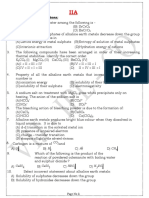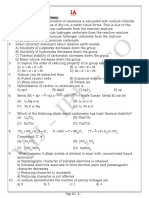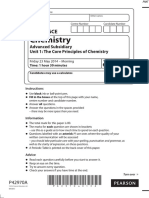P-Block DTS-2
P-Block DTS-2
Uploaded by
Rudra guptaCopyright:
Available Formats
P-Block DTS-2
P-Block DTS-2
Uploaded by
Rudra guptaCopyright
Available Formats
Share this document
Did you find this document useful?
Is this content inappropriate?
Copyright:
Available Formats
P-Block DTS-2
P-Block DTS-2
Uploaded by
Rudra guptaCopyright:
Available Formats
Date Planned : __ / __ / __ Daily Tutorial Sheet-2 Expected Duration : 30 Min
Actual Date of Attempt : __ / __ / __ Level-1 Exact Duration :_________
16. In group 13, Tl (thalium) shows +1 oxidation state while other members show +3 oxidation state, why ?
(A) Presence of lone electron in Tl (B) Inert pair effect
(C) Large ionic radius of Tl ion (D) None of these
17. Correct order of bond angles in the given compounds is/are :
(A) (B) (C) (D) can't be predicted
18. The correct order of increasing atomic radii, is :
(A) B < Al < Ga (B) Ga < Al < B (C) Al < B < Ga (D) B < Ga < Al
19. Which type of silicate is shown in the given figure ?
(A) Orthosilicate
(B) Pyrosilicate
(C) Sheet silicate
(D) None of these
20. Buckminister-fullerene is a variety of :
(A) Boron (B) Carbon (C) Sulphur (D) Phosphorous
21. The basic structural unit in silicate is :
(A) SiO2 (B) [Si2O7 ]2 (C) SiO44 (D) [Si2O5 ]2
22. What product is formed on heating lead nitrate ?
(A) PbO NO O2 (B) PbO NO2 O2 (C) Pb NO2 (D) PbO N 2
23. Among the following substituted silanes the one which will give rise to cross linked silicone polymer on
hydrolysis is :
(A) R 4 Si (B) RSiCl3 (C) R 2SiCl 2 (D) R 3 SiCl
1000C Carbon
24. Identify B in the following reaction, H4 SiO4
A
B CO :
H2 O
(A) Corundum (B) Quartz (C) Silica (D) Carborundum
25. In silica (SiO2 ), each silicon is bonded to :
(A) Two oxygen atoms (B) Four oxygen atoms
(C) One silicon and two oxygen atoms (D) One silicon and four oxygen atoms
26. The incorrect statements among the following is/are :
I. Fullerene is molecular solid
II. Lead prefers to form tetravalent compounds
III. The three C O bonds are not equal in the carbonate ion
IV. Both B2 and C2 are paramagnetic
(A) I, III and IV (B) I and IV (C) II, III and IV (D) I and III
VMC | Level-1 128 DTS-2 | p-Block Elements-1
27. The stability of dihalides of Si, Ge Sn and Pb increases steadily in the sequence :
(A) GeX 2 SiX 2 SnX 2 PbX 2 (B) SiX 2 GeX 2 PbX 2 SnX 2
(C) SiX 2 GeX 2 SnX 2 PbX 2 (D) SiX 2 GeX 2 PbX 2 SnX 2
28. In SiF62 and SiCl26 which one is known and why ?
(A) SiF62 because of small size of F (B) SiF62 because of large size of F
(C) SiCl26 because of small size of Cl (D) SiCl26 because of large size of Cl
29. Graphite is a soft solid lubricant extremely difficult to melt. The reason for this anomalous behaviour is
that, graphite :
(A) Is a non-crystalline substance
(B) Is an allotropic form of diamond
(C) Has molecules of variable molecular masses like polymers
(D) Has carbon atoms arranged in large plates of rings of strongly bound carbon atoms with weak
interpolate bonds
30. Water glass is :
(A) Glass made of water (B) Sodium silicate
(C) Calcium formate (D) Pyrex glass
VMC | Level-1 129 DTS-2 | p-Block Elements-1
You might also like
- Chapter (The P-Block Elements)Document14 pagesChapter (The P-Block Elements)AtulNo ratings yet
- Carbon Family (Exercise) Module-2-1Document10 pagesCarbon Family (Exercise) Module-2-1Raju SinghNo ratings yet
- Chemistry Test S Block and P BlockDocument3 pagesChemistry Test S Block and P BlockRk kashyapNo ratings yet
- Quiz-P-Block Elements - Boron & Carbon Family-Snd - SNDDocument4 pagesQuiz-P-Block Elements - Boron & Carbon Family-Snd - SNDAyush ChouhanNo ratings yet
- S Block Question Bank 1Document7 pagesS Block Question Bank 1Ashutosh TripathiNo ratings yet
- P - Block (13, 14)Document14 pagesP - Block (13, 14)suryakala.ganapathyNo ratings yet
- P-Block DTS-3Document2 pagesP-Block DTS-3Rudra guptaNo ratings yet
- S Block (Micro)Document17 pagesS Block (Micro)Anant JainNo ratings yet
- Test - 2 Single Choice QuestionsDocument11 pagesTest - 2 Single Choice QuestionsGod is every whereNo ratings yet
- IOC - IRP - Home Test-2 (Without Answer) - SendDocument11 pagesIOC - IRP - Home Test-2 (Without Answer) - SendNicholas BourbakiNo ratings yet
- Exercise-01 Check Your Grasp: K Cro Dil. HCLDocument20 pagesExercise-01 Check Your Grasp: K Cro Dil. HCLAkashGauravNo ratings yet
- Group-14 06-01-2021Document4 pagesGroup-14 06-01-2021ishanashtake009No ratings yet
- DPP-30 - Che. (Phy)Document2 pagesDPP-30 - Che. (Phy)aayushshandilya2006No ratings yet
- ChemistryTestPaper 1Document4 pagesChemistryTestPaper 1tapanmukhopadhyay066No ratings yet
- Single Answer Type Questions:: (D) Absorption of Light by The Solvated ElectronsDocument4 pagesSingle Answer Type Questions:: (D) Absorption of Light by The Solvated Electronssree anugraphicsNo ratings yet
- QN Paper 009 2020Document14 pagesQN Paper 009 2020Aswathy MenonNo ratings yet
- Bond SheetDocument40 pagesBond SheetAkash Mukherjee100% (2)
- D and F Block DPPDocument4 pagesD and F Block DPPKalyan ReddtNo ratings yet
- JEE Main D and F Block Elements Important Questions (2023-24)Document11 pagesJEE Main D and F Block Elements Important Questions (2023-24)dheena25521No ratings yet
- Class Test-8 - JEE Adv - CC - Metallurgy - E - WADocument5 pagesClass Test-8 - JEE Adv - CC - Metallurgy - E - WAhimay shahNo ratings yet
- Coordination CompoundsDocument27 pagesCoordination CompoundsIndranilNo ratings yet
- Final Question Carbon FamilyDocument23 pagesFinal Question Carbon FamilyShyamNarayanAgarwalNo ratings yet
- 4.CPP S BlockDocument6 pages4.CPP S BlockRuchira SahaNo ratings yet
- CHEMISTRY QUESTION IN ENGLISH 5Document16 pagesCHEMISTRY QUESTION IN ENGLISH 5anurajNo ratings yet
- Quiz-P-Block - Group 13-14Document4 pagesQuiz-P-Block - Group 13-14gajalaspj786No ratings yet
- 07 S and P Block Elements Que. Final E 3Document16 pages07 S and P Block Elements Que. Final E 3gnkstarNo ratings yet
- Carbon & Boron DPPDocument5 pagesCarbon & Boron DPPKalyan ReddtNo ratings yet
- Probability Basic Module (Batch +1)Document6 pagesProbability Basic Module (Batch +1)Tarun ChaudharyNo ratings yet
- S-Block (Jee Mains+Neet)Document10 pagesS-Block (Jee Mains+Neet)viratdhoni1872001No ratings yet
- S - Block Elements PDFDocument14 pagesS - Block Elements PDFPankaj MauryaNo ratings yet
- P - Block Elements MCQ TestDocument7 pagesP - Block Elements MCQ Testshubhamthakur1876No ratings yet
- Part - I: Subjective Questions: Section (A) : General Facts About ElementsDocument24 pagesPart - I: Subjective Questions: Section (A) : General Facts About ElementsRadhika PuralaNo ratings yet
- Exercise - 1 Iit/Jee: (Single Correct Choice Type Questions)Document28 pagesExercise - 1 Iit/Jee: (Single Correct Choice Type Questions)Paliwal DineshNo ratings yet
- Exercise-01 Check Your GraspDocument31 pagesExercise-01 Check Your GraspHet PrajapatiNo ratings yet
- DPP-8-9 (Metal and Non Metal) .DT 11.11.2024Document2 pagesDPP-8-9 (Metal and Non Metal) .DT 11.11.2024gameradityaguptaNo ratings yet
- 02 Exercise5Document21 pages02 Exercise5AkashGauravNo ratings yet
- Exercise With Ans FinalDocument24 pagesExercise With Ans Finald anjilappa25% (4)
- Chemistry Test Transition Elements Dt.14.01.2024Document3 pagesChemistry Test Transition Elements Dt.14.01.2024shaurya7rNo ratings yet
- PDF NO ANS 2024 Assgnment of S Block XII CHapter 1Document6 pagesPDF NO ANS 2024 Assgnment of S Block XII CHapter 1sidhu160saabNo ratings yet
- 12 Book Back One Mark EMDocument33 pages12 Book Back One Mark EMpugazhendhi4488No ratings yet
- S-Block - 4-1Document4 pagesS-Block - 4-1Arav KumarNo ratings yet
- 50 Expected QuestionsDocument6 pages50 Expected QuestionsShadhasanNo ratings yet
- The P-Block Elements 14-6-22Document7 pagesThe P-Block Elements 14-6-22algostockstradingNo ratings yet
- ECAT Test 7 Chem KeyDocument2 pagesECAT Test 7 Chem Keysheikhabaidullah001No ratings yet
- ExerciseDocument13 pagesExercised anjilappaNo ratings yet
- DPP1 SBlock Advan6264893396548698825Document4 pagesDPP1 SBlock Advan6264893396548698825Drushya SalunkeNo ratings yet
- Chem-II Full Book Mcq's 2024Document7 pagesChem-II Full Book Mcq's 2024usman6969696969No ratings yet
- Single Answer Type Questions:: Li Na K RB Li Na K RB Na Li K RB Na K Li RBDocument5 pagesSingle Answer Type Questions:: Li Na K RB Li Na K RB Na Li K RB Na K Li RBsree anugraphicsNo ratings yet
- S-Block Elments: Inorganic ChemistryDocument8 pagesS-Block Elments: Inorganic ChemistryRSLNo ratings yet
- CC 2Document2 pagesCC 2Sejal KhandelwalNo ratings yet
- Part - I: Subjective Questions: MetallurgyDocument19 pagesPart - I: Subjective Questions: MetallurgyGOURISH AGRAWALNo ratings yet
- Sheet - 01 - Coordination CompoundDocument62 pagesSheet - 01 - Coordination CompoundloharerakhiNo ratings yet
- P Block - Practice SheetDocument5 pagesP Block - Practice SheetAayushi gargNo ratings yet
- Question Bank On S-BLOCK ELMENTSDocument7 pagesQuestion Bank On S-BLOCK ELMENTSSnehaNo ratings yet
- S-Block (Exercise) Module-2-1Document11 pagesS-Block (Exercise) Module-2-1Raju SinghNo ratings yet
- 3 Metals and Non MetalsDocument3 pages3 Metals and Non MetalsManmohan AggarwalNo ratings yet
- Quiz Chemical Bonding JsDocument3 pagesQuiz Chemical Bonding Jsmrbipulkr0001No ratings yet
- CMS Quiz-S-Block & HydrogenDocument3 pagesCMS Quiz-S-Block & HydrogenOM SHUKLANo ratings yet
- D and F Block Elements - AssignmentDocument9 pagesD and F Block Elements - AssignmentlavenyaNo ratings yet
- P-Block Elements-II - DTS 2 Main (Archive) SolDocument2 pagesP-Block Elements-II - DTS 2 Main (Archive) SolRudra guptaNo ratings yet
- P-Block Elements-II - DTS 2 Main (Archive)Document2 pagesP-Block Elements-II - DTS 2 Main (Archive)Rudra guptaNo ratings yet
- Coordination Compounds - DTS 0Document2 pagesCoordination Compounds - DTS 0Rudra guptaNo ratings yet
- P-Block DTS-5Document2 pagesP-Block DTS-5Rudra guptaNo ratings yet
- Coordination Compounds - DTS 1Document2 pagesCoordination Compounds - DTS 1Rudra guptaNo ratings yet
- Coordination Compounds - DTS 0 SolDocument10 pagesCoordination Compounds - DTS 0 SolRudra guptaNo ratings yet
- Periodic Properties Solution - DTS-1Document1 pagePeriodic Properties Solution - DTS-1Rudra guptaNo ratings yet
- P-Block DTS-4Document2 pagesP-Block DTS-4Rudra guptaNo ratings yet
- Periodic Properties Solution - DTS-2 - JEE Adv ArchiveDocument2 pagesPeriodic Properties Solution - DTS-2 - JEE Adv ArchiveRudra guptaNo ratings yet
- Periodic Properties Solution - DTS-1 - JEE Main ArchiveDocument1 pagePeriodic Properties Solution - DTS-1 - JEE Main ArchiveRudra guptaNo ratings yet
- Binomial Theorem DTS-3111Document2 pagesBinomial Theorem DTS-3111Rudra guptaNo ratings yet
- P-Block DTS-3Document2 pagesP-Block DTS-3Rudra guptaNo ratings yet
- 1111binomial Theorem DTS-5Document2 pages1111binomial Theorem DTS-5Rudra guptaNo ratings yet
- Binomial Theorem DTS-41111Document2 pagesBinomial Theorem DTS-41111Rudra guptaNo ratings yet
- Binomial Theorem DTS-1111Document2 pagesBinomial Theorem DTS-1111Rudra guptaNo ratings yet
- AA 3105-F Tread/Chequered Plates: Aluminium AlloyDocument1 pageAA 3105-F Tread/Chequered Plates: Aluminium AlloyAbolfazl HabibiNo ratings yet
- Science 9 Q2 Week 2Document8 pagesScience 9 Q2 Week 2harley_quinn11100% (1)
- 1 Atoms, Stoichiometry and Redox: Section ADocument16 pages1 Atoms, Stoichiometry and Redox: Section AloxadegoNo ratings yet
- Chapter 3: The Mole Concept, Chemical Formula and Equation: Bab 3: Konsep Mol, Formula Dan Persamaan KimiaDocument31 pagesChapter 3: The Mole Concept, Chemical Formula and Equation: Bab 3: Konsep Mol, Formula Dan Persamaan Kimiaintan noraisyahNo ratings yet
- Limiting Reagents: Cao + H O Ca (Oh)Document3 pagesLimiting Reagents: Cao + H O Ca (Oh)nataliaprusek1No ratings yet
- Elements and The PeriodicDocument51 pagesElements and The PeriodicLukman ArimartaNo ratings yet
- Lassign's TestDocument7 pagesLassign's TestDhruv.bhardwajNo ratings yet
- Class XI Chem.Document6 pagesClass XI Chem.ImmortalNo ratings yet
- Chemistry Assessment 1Document12 pagesChemistry Assessment 1Nayyir Mumtasir Rahman 2323059047No ratings yet
- Medical Laboratory Technology Journal: Kadar Logam Timbal (PB) Dalam Darah Penjual KleponDocument6 pagesMedical Laboratory Technology Journal: Kadar Logam Timbal (PB) Dalam Darah Penjual Kleponmirma destatiNo ratings yet
- Jasper 1972Document169 pagesJasper 1972ManuelLentiNo ratings yet
- Scope TC 5451Document12 pagesScope TC 5451Nishikant KathokeNo ratings yet
- Brass Plating - Galvanica Consonni (Good Article)Document4 pagesBrass Plating - Galvanica Consonni (Good Article)Homayoon GeramifarNo ratings yet
- Word Problems in Organic ChemistryDocument70 pagesWord Problems in Organic ChemistryreghuuchihaNo ratings yet
- ASTM A193Document1 pageASTM A193Remon NabilNo ratings yet
- Lesson Plan in Grade 9 Science: A. Routinary ActivitiesDocument7 pagesLesson Plan in Grade 9 Science: A. Routinary ActivitiesJUNELLIE TAJONERANo ratings yet
- 16.p Block Element ExerciseDocument27 pages16.p Block Element ExerciseKIRAN ALLUNo ratings yet
- Section 2 Strengths of Acids and BasesDocument3 pagesSection 2 Strengths of Acids and BasesDevine RawlsNo ratings yet
- BenedictDocument5 pagesBenedictMark Justin LealNo ratings yet
- Lecture 4 NotesDocument31 pagesLecture 4 NotesSophia WambuiNo ratings yet
- June 2014 MS - Unit 1 Edexcel Chemistry A-LevelDocument24 pagesJune 2014 MS - Unit 1 Edexcel Chemistry A-LevelNabindra RuwaliNo ratings yet
- 11 Cbse Chemistry Organic ChemistryDocument22 pages11 Cbse Chemistry Organic ChemistryKrish KakkarNo ratings yet
- 金属有机化学课件 PDFDocument408 pages金属有机化学课件 PDFmingNo ratings yet
- 6679 - Silver Nitrate TestDocument4 pages6679 - Silver Nitrate Testkavi bryant100% (1)
- IodometryDocument24 pagesIodometrywildan jrNo ratings yet
- Inorganic Chemistry - ChemistryDocument1 pageInorganic Chemistry - ChemistryHare KrishnaNo ratings yet
- Electricity and ChemistryDocument9 pagesElectricity and ChemistryFrancis EssilfieNo ratings yet
- GravimetricDocument9 pagesGravimetricLuneth SalazarNo ratings yet
- Formula Sheets R1Document27 pagesFormula Sheets R1AnnNo ratings yet
- Experiment 3 Corrosion RateDocument5 pagesExperiment 3 Corrosion RatefatinNo ratings yet







































































































